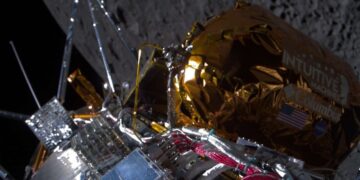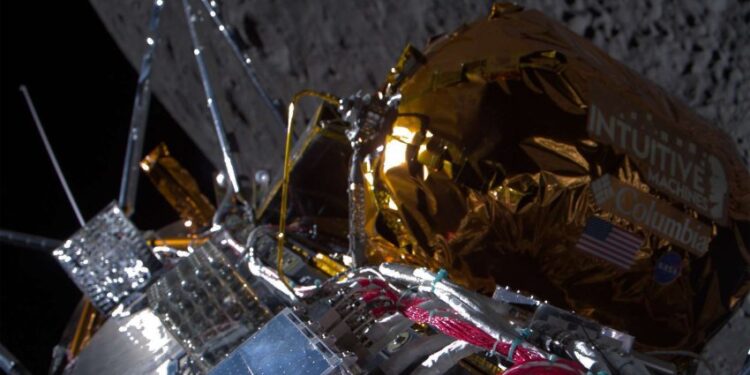By Lucy Adautin
A Houston-based company has achieved a significant milestone by successfully landing America’s first spacecraft on the Moon in over 50 years.
This achievement marks the beginning of a new era with NASA-funded, uncrewed commercial robots aimed at preparing for astronaut missions in the coming years.
Although flight controllers confirmed receiving a faint signal, the status of Odysseus, the lander developed by Intuitive Machines, remains uncertain. Announcers on a live stream suggested that the lander may have touched down off-kilter.
The hexagon-shaped vessel landed near the lunar south pole at 23:23 GMT, decelerating from a speed of 4,000 miles (6,500 kilometers) per hour. Images from an external “EagleCam,” intended to capture the final moments of descent may be released later.
At present, there is uncertainty regarding the lander’s functionality, and further assessments are required to determine its status.
“Without a doubt our equipment is on the surface of the Moon and we are transmitting,” said Tim Crain, the company’s chief technology officer. “So congratulations IM team, we’ll see how much more we can get from that.”
Another American company’s recent attempt to land on the moon ended in failure, emphasizing the importance of demonstrating the capabilities of the private industry to achieve a milestone last accomplished by NASA’s Apollo 17 mission in 1972.
The current mission “will be one of the first forays into the south pole to actually look at the environmental conditions to a place we’re going to be sending our astronauts in the future,” said senior NASA official Joel Kearns.
READ ALSO: JUST IN: Nigerian Senator Who Made Budget Padding Claims Suspended For Three Months
Launched on February 15 via a SpaceX Falcon 9 rocket, Odysseus is equipped with an innovative supercooled liquid oxygen and liquid methane propulsion system, enabling swift travel through space. Its landing site, Malapert A, lies within an impact crater located 300 kilometers (180 miles) from the lunar south pole.
Under NASA’s Artemis program, the long-term goal is to establish a sustainable presence on the moon and utilize resources such as ice for drinking water and rocket fuel.
Odysseus is equipped with various instruments, including cameras to monitor changes in the lunar surface caused by spaceship engine plumes, and a device to analyze charged dust particles present in twilight clouds due to solar radiation. Additionally, it features a NASA landing system utilizing laser pulses to accurately gauge velocity and distance from the surface, crucial for avoiding catastrophic impacts.
During the descent phase, Odysseus encountered navigation system issues, prompting controllers to rely solely on the NASA landing system. Despite this challenge, a software patch was successfully uploaded to facilitate a safe landing.


































